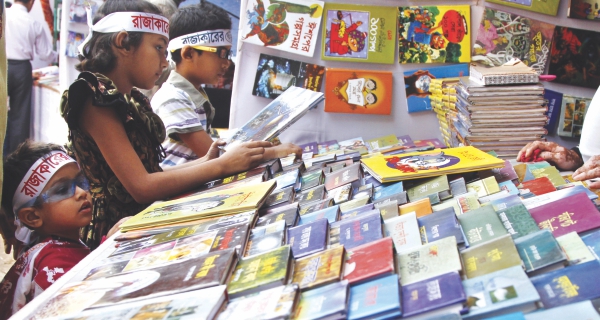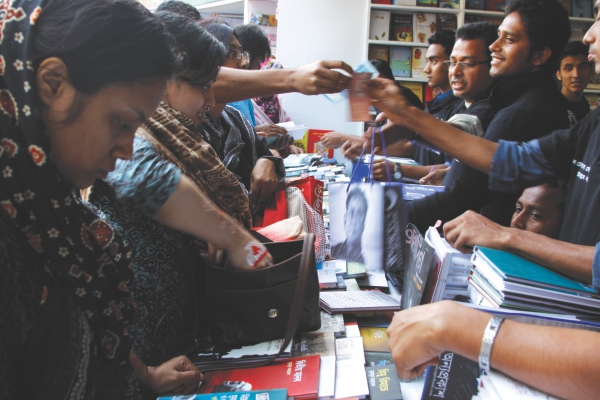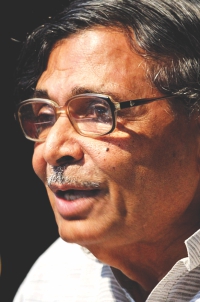| Home - Back Issues - The Team - Contact Us |
 |
| Volume 12 |Issue 08| February 22, 2013 | |
|
|
Ekushey Boimela
A Different Ekushey Zahir Hassan Nabil Events unfold, we think as we observe, we spell out ideas in the form of speech and we listen, we engage in monologues, then dialogue with others. And narratives then take concrete shapes onto the pages. We read, reread the thoughts of others and dialogues again carve into clear black letters, finding their way to crisp new pages. Once again the Ekushey Boimela brought forth those fresh narratives on the Bangla Academy premises. Nevertheless with the Shahbag Mass movement right at the doorstep, the Ekushey Boimela experience has been a little different. Publishers, who happen to be the bridge between the authors and the readers, consider this year's gathering a tad different, yet something to appreciate and celebrate. They say the presence of the crowd, although a few yards away, will certainly be looked upon as a cultural memory of the month of the language movement. Syed Zakir Hussain, of Adorn publishers, prefers not to use the word 'affected' in case of the boimela due to the Shahbag mass movement. He clarifies, “We don't see the book fair as a place for abundant selling out of books; rather it is a space for the readers to engage in new ideas whilst the publishers have a scope to experiment. We want readers to browse through, analyse and ponder.” For Hussain, the infrequent presence of bibliophiles this year is not something to worry about as he mentions, “We have specific readers for our research and critique-based publications as well as for our children series. We have not lost them at all.”
Indeed from such a perspective, the Shahbag movement might have sifted the real readers from the casual visitors. Ahmed Mahmudul Haque of Mowla Brothers says, “On the first week we had everything running in full swing, the number of people gradually lessened but I think the visitors-only were absent, not the readers. Last Friday, we had a full crowd and whoever appeared in the fair bought something I think.” Farid Ahmed of Somoy Publication however preferred the first half of last year's boimela to this year. “The sale has been a bit dull on weekdays,” he says. Not just for the city dwellers, Ekushey Boimela is a very sought after event for many all across the country. Like some publishers, Robin Ahsan of Srabon thinks many from that group did not come this year. Ahsan also thinks some of the inextricable events of the boimela are missing this year, “In all past occasions, we organised boi-adda at our stall with authors and critics as discussants in the presence of media and journalists. Unfortunately, we couldn't arrange anything until now for things have been different this year.” Ahsan, like most publishers, said that readers of critical commentaries and essays are increasing. On the other hand, the consumers of popular fiction are on the decline because alternative forms of entertainment are much-hyped at present. “As far as readership is concerned, critical writing has a bright future,” he says. Shahidul Islam Bizu of Pathak Samabesh asserts that there are distinct groups of readers for certain genres, namely research, critiques, treatises on media and politics etc. “Our selective readers groups await their preferred books to be released in the boimela. I think our sale was unaffected,” he says. With the Shahbagh movement reigniting the spirit of Liberation War, has the crowd been inspired to read more on 1971, cultural history and politics? It is hard to figure out. Monirul Hoque of Anannya thinks books around the topic of the Liberation War are selling well as usual. “But I don't think this is just because of the Shahbag movement,” he says. A bunch of enthusiastic young men and women, soaked in the untimely drizzle this week, was seen surrounding the stall of Centre for Bangladesh Liberation War Studies. They were carefully scanning thick volume titles and then hastened to skim through one after the other. Salesperson Shamsul Haq informs young people have been the major buyers in the last two weeks.
It is unanimously agreed that novels had always made the waves since the inception of the boimela. It may be that readership for the selective critical publication has not declined but what about the prolific and popular novelists? The stall of Annyaprakash, that notably publishes works of the deceased litterateur Humayun Ahmed, had an overhanging gloominess in its decoration. Publisher Mazharul Islam thinks Ahmed's readers are rediscovering his works in his absence. “They want to have all unread pieces at hand on this occasion. Shahbag may have impacted citywide communication but it is drawing more young people to the boimela I think,” he says. Of children's literature, some parents have complained about low-quality graphics and dull content. One of Shafina Ahmed's children frowns at a book while the other frolics around with a few new books dangling from his little backpack. Shafina found the new publications disappointing compared to last year's books. “Children's literature is one of the most difficult things to produce; just anyone cannot write stories to entertain children. Some illustrations are horrible; good reads are extremely rare except for some selected publications,” she explains. In this year's boimela, 274 publishers have so far released around 2000 books in a little more than two weeks. Notwithstanding the different festivity, the publishers very much look forward to more engaging activities of the readers and authors on the remaining days. *** ABDULLAH ABU SAYEED
When the culture of reading books is said to be on the wane, the man behind Bishwa Sahitya Kendra thinks otherwise: “In the good old days of our childhood, a cloak of murk used to descend when twilight softened; people hardly had anything to do but sleep in the evening. Books were the only source of entertainment until the advent of modern media. Nonetheless avid reading is very much in existence today as well. It is just the readers craving cheap writing who have shifted to the modern media for entertainment. The real readers have not been affected whatsoever. And regarding the intangible books on the computer – there used to be engravings on the stone, leaves, and then paper – they just come in different forms. One has to be contemplative and reflective while reading a book. A reader is half a philosopher; they are the ones willing to bring positive changes. So, there is a distinct group of readers, regardless of their age, always on the lookout for a bigger picture. An enthusiastic bunch of those who would have attended the boimela are at Shahbag this year; for a greater necessity, I believe."
|
||||
Copyright
(R) thedailystar.net 2013 |



